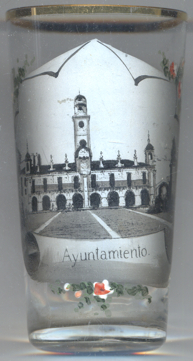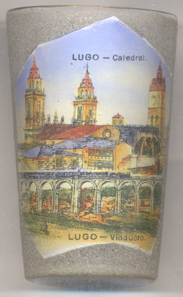

|
| ESPAÑA | Spain |
| Galicia | |
| Provincia da Lugo |
Lugo is situated at an altitude of 465 m on the river Miño in the east of the Spanish autonomous region Galicia. Lugo is the capital of the province Lugo; the municipality has a population of about 98,300 (2016), thus being the fourth most populous city in Galicia (after Vigo, A Coruña and Ourense).

 The city was probably founded by Celtic inhabitants of the region and dedicated to Lugos, a pan-Celtic God of light, oaths
and arts. Conquered by the Romans in 13 BC it was called Lucus Augusti. Though small, it was the most important
Roman town in what became Gallaecia during the Roman period, the seat of a 'conventus', one of three in Gallaecia, and later
became one of the two capitals of Gallaecia. Lugo is the only city in the world to be surrounded by completely intact Roman
walls, which reach a height of 10 to 15 metres along a 2,117-metre circuit ringed with 71 towers. The walk along the top is
continuous round the circuit, and features ten gates. In 2000, these 3rd-century walls were listed by UNESCO as a
World Heritage Site. Lucus was the seat of a bishopric by the later 5th century at the latest
and remained an administrative center under the Suebi and Visigoths, before going into such a decline that the site was
found to be deserted in the middle of the 8th century. 10th-century attempts at rebuilding its 'casas destructas' (abandoned
tenements suggest that it remained a town only on paper: the seat of a bishopric, administered by a count, from which royal
charters were issued. During the Middle Ages, Lugo, like Santiago de Compostela, was a center of pilgrimage, because the
cathedral had the special privilege, which it still retains today, of exposing to the public the consecrated host
twenty-four hours a day. During the Modern Age, Lugo had a certain supremacy, although other nearby towns such as
Mondoñedo or Ribadeo disputed it. It was not until the division of the state into provinces in 1833 and the creation
of provincial governments that Lugo has become the most important town from the province of Lugo, because of its capital
status.
The city was probably founded by Celtic inhabitants of the region and dedicated to Lugos, a pan-Celtic God of light, oaths
and arts. Conquered by the Romans in 13 BC it was called Lucus Augusti. Though small, it was the most important
Roman town in what became Gallaecia during the Roman period, the seat of a 'conventus', one of three in Gallaecia, and later
became one of the two capitals of Gallaecia. Lugo is the only city in the world to be surrounded by completely intact Roman
walls, which reach a height of 10 to 15 metres along a 2,117-metre circuit ringed with 71 towers. The walk along the top is
continuous round the circuit, and features ten gates. In 2000, these 3rd-century walls were listed by UNESCO as a
World Heritage Site. Lucus was the seat of a bishopric by the later 5th century at the latest
and remained an administrative center under the Suebi and Visigoths, before going into such a decline that the site was
found to be deserted in the middle of the 8th century. 10th-century attempts at rebuilding its 'casas destructas' (abandoned
tenements suggest that it remained a town only on paper: the seat of a bishopric, administered by a count, from which royal
charters were issued. During the Middle Ages, Lugo, like Santiago de Compostela, was a center of pilgrimage, because the
cathedral had the special privilege, which it still retains today, of exposing to the public the consecrated host
twenty-four hours a day. During the Modern Age, Lugo had a certain supremacy, although other nearby towns such as
Mondoñedo or Ribadeo disputed it. It was not until the division of the state into provinces in 1833 and the creation
of provincial governments that Lugo has become the most important town from the province of Lugo, because of its capital
status.
The  town hall (Casa de Consello) [left, no. 3341] is a Baroque structure with a
mid-18th century façade. Annexed is a clock tower, originally from the 16th century, but rebuilt later.
town hall (Casa de Consello) [left, no. 3341] is a Baroque structure with a
mid-18th century façade. Annexed is a clock tower, originally from the 16th century, but rebuilt later.

 Lugo cathedral (Catedral de Santa María) [near left, no. 3662: top, background]
was erected in the early 12th century in a Romanesque style, with Gothic, Baroque and Neoclassicist elements.
A church existed in the site from 755. In 1129 a new edifice in the latest architectural style was commissioned. This
Romanesque structure was completed in 1273. Later renovations and restorations added elements in other styles, such as the
Renaissance retablo at the high altar. It was destroyed in the 1755 Lisbon earthquake and fragments of it are housed in the
church. The cathedral is well-known for its privilege to permanently expose the Holy Sacrament, which is also commemorated
in the armorial bearings of the town.
Lugo cathedral (Catedral de Santa María) [near left, no. 3662: top, background]
was erected in the early 12th century in a Romanesque style, with Gothic, Baroque and Neoclassicist elements.
A church existed in the site from 755. In 1129 a new edifice in the latest architectural style was commissioned. This
Romanesque structure was completed in 1273. Later renovations and restorations added elements in other styles, such as the
Renaissance retablo at the high altar. It was destroyed in the 1755 Lisbon earthquake and fragments of it are housed in the
church. The cathedral is well-known for its privilege to permanently expose the Holy Sacrament, which is also commemorated
in the armorial bearings of the town.
The  Viaduto da Chanca [near left, no. 3662: bottom, foreground]
spans the river Chanca and was built for the passage of the A Coruña–Palencia
railway. It was constructed in 1871–1874 under the direction of the engineer Ángel García del Hoyo.
It has a length of 298 meters and a maximum height of 29 metres, with 20 arches with a span of 9.5 m each.
Viaduto da Chanca [near left, no. 3662: bottom, foreground]
spans the river Chanca and was built for the passage of the A Coruña–Palencia
railway. It was constructed in 1871–1874 under the direction of the engineer Ángel García del Hoyo.
It has a length of 298 meters and a maximum height of 29 metres, with 20 arches with a span of 9.5 m each.
[https://de.wikipedia.org/wiki/Lugo, https://en.wikipedia.org/wiki/Lugo;
https://en.wikipedia.org/wiki/Lugo_Cathedral;
https://gl.wikipedia.org/wiki/Viaduto_da_Chanca, https://www.lavozdegalicia.es/noticia/lugo/lugo/2019/02/03/puente-span-langgl-chancaspan-150-anos-tren/0003_201902L3C2994.htm]
![[scale]](lineal.jpg)